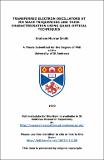Files in this item
Transferred electron oscillators at MM wave frequencies and their characterisation using quasi-optical techniques
Item metadata
| dc.contributor.advisor | Lesurf, J. C. G. | |
| dc.contributor.author | Smith, Graham Murray | |
| dc.coverage.spatial | 342 p. | en_US |
| dc.date.accessioned | 2017-06-28T13:09:03Z | |
| dc.date.available | 2017-06-28T13:09:03Z | |
| dc.date.issued | 1990 | |
| dc.identifier | uk.bl.ethos.320530 | |
| dc.identifier.uri | https://hdl.handle.net/10023/11106 | |
| dc.description.abstract | A study of high frequency millimetre wave oscillators is performed operating at W- band and above, using test bench equipment designed and constructed in St. Andrews. Octave tuneable oscillators have been designed, constructed, and used to characterise developmental Gunn devices, as well as to provide ideal oscillators for test bench measurement systems. These oscillators have been sold to many millimetre-wave laboratories throughout Britain. The operation, optimisation and characterisation of these oscillators is described in detail, and various non-linear effects are explained and modelled successfully. The wideband tuneability and matching has also allowed evaluation of new developmental Gunn devices to accurately determine the optimum operating frequency range of the devices. This was part of a developmental program by GEC Hirst and MEDL which has now produced state of the art GaAs Gunn oscillators at 94GHz. Much of the characterisation of the oscillators is performed using novel quasi-optical techniques, which has allowed low loss accurate performance at these very high frequencies. Several quasi-optical techniques are described and the design, manufacture and evaluation of many optical components are given. In particular, the frequency and harmonic content of the oscillators was determined using a Martin-Puplett Interferometer which utilised a frequency counting technique. This enabled easy wideband measurements to be performed with much greater accuracy than traditional cavity wavemeters. In addition, a state of the art noise bench has been designed and constructed for operation at W -band and above, that utilises a novel open resonator to effect a very high Q suppression filter. The system has been shown to make noise measurements at much lower power levels and with greater sensitivity than comparable systems. | en_US |
| dc.language.iso | en | en_US |
| dc.publisher | University of St Andrews | |
| dc.subject.lcc | TK7872.O7S6 | |
| dc.subject.lcsh | Oscillators, Electric | en |
| dc.title | Transferred electron oscillators at MM wave frequencies and their characterisation using quasi-optical techniques | en_US |
| dc.type | Thesis | en_US |
| dc.type.qualificationlevel | Doctoral | en_US |
| dc.type.qualificationname | PhD Doctor of Philosophy | en_US |
| dc.publisher.institution | The University of St Andrews | en_US |
This item appears in the following Collection(s)
Items in the St Andrews Research Repository are protected by copyright, with all rights reserved, unless otherwise indicated.

